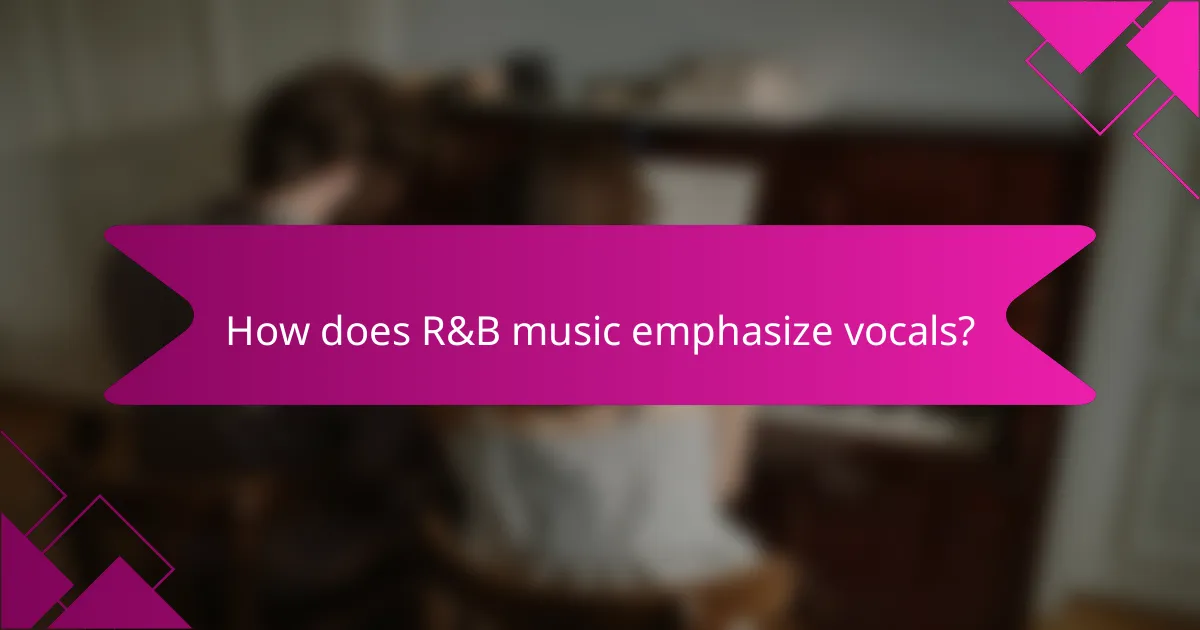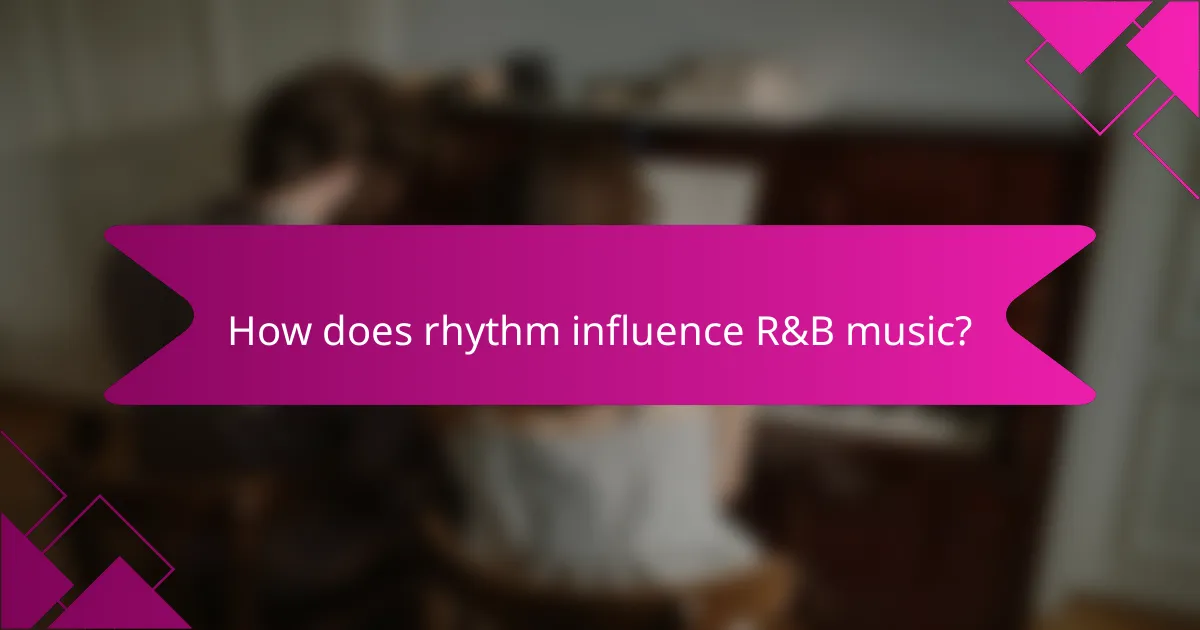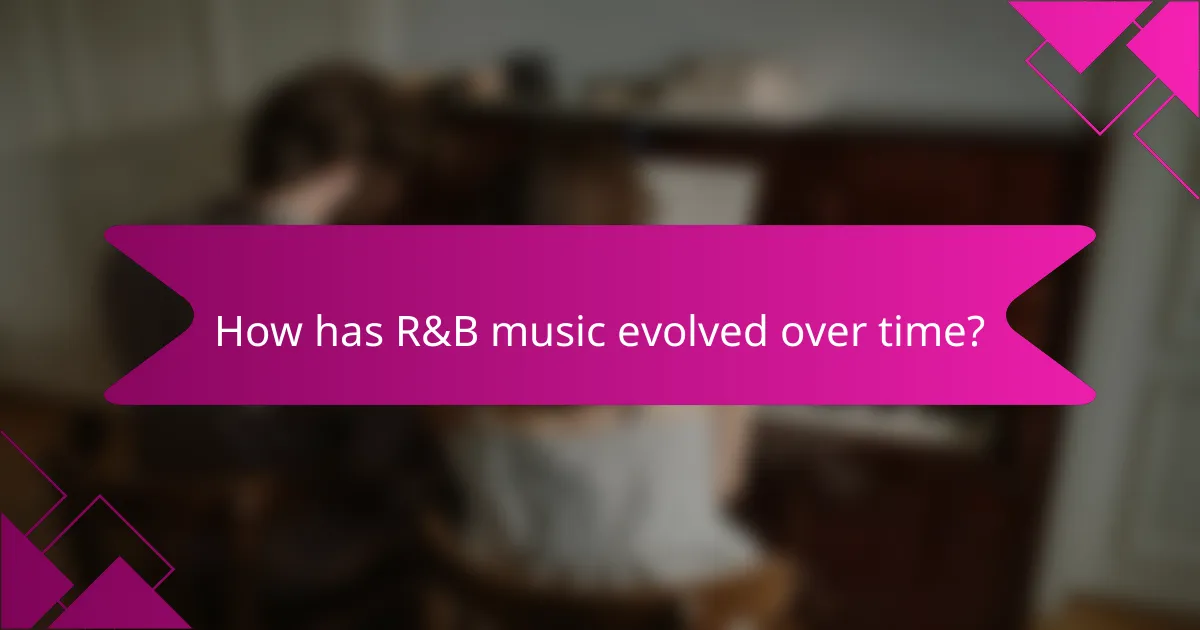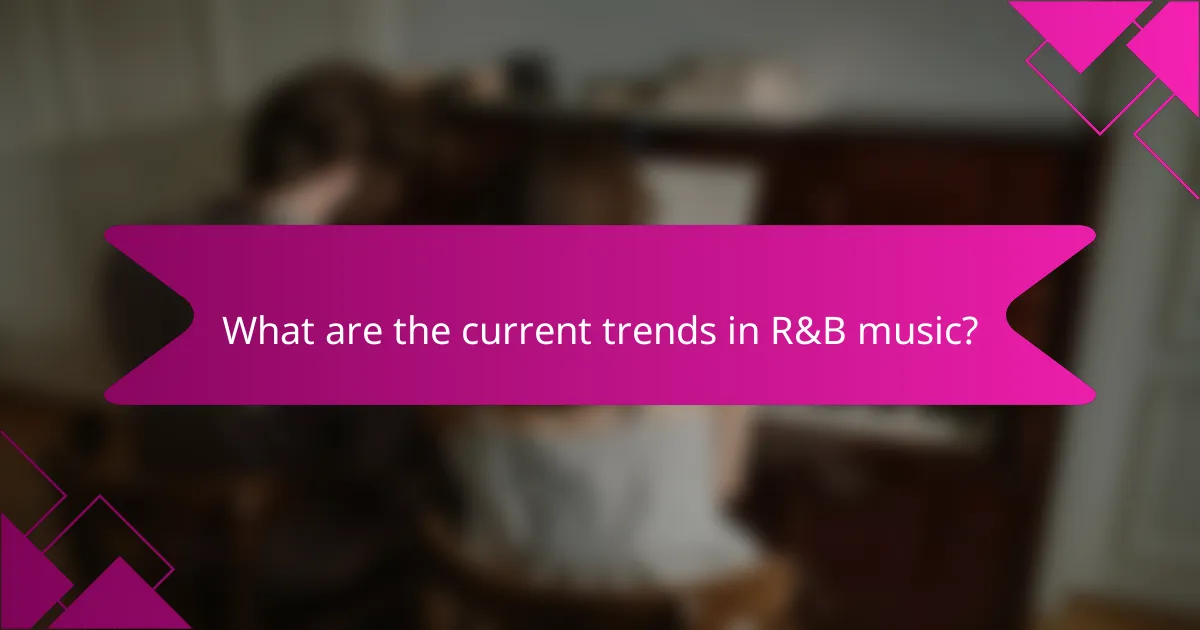R&B music is characterized by its strong vocal emphasis, allowing singers to convey deep emotional expressions through rich melodies and heartfelt lyrics. This genre masterfully combines rhythmic grooves with powerful vocal performances, creating a captivating sound that resonates with listeners and evokes feelings of love, heartbreak, and longing.

How does R&B music emphasize vocals?
R&B music places a strong emphasis on vocals by showcasing the singer’s emotional expression and technical skills. This genre often highlights the voice as the primary instrument, allowing for a deep connection with the audience through rich melodies and heartfelt lyrics.
Vocal techniques in R&B
R&B vocal techniques include a variety of styles such as belting, head voice, and falsetto. Singers often switch between these techniques to convey different emotions and dynamics within a song. The ability to control pitch and volume is crucial, as it enhances the overall expressiveness of the performance.
Additionally, breath control plays a significant role in R&B singing. Artists often use techniques like diaphragmatic breathing to sustain notes and create a smoother sound. This allows for longer phrases and a more fluid delivery, which is essential in captivating listeners.
Influence of gospel traditions
Gospel music has profoundly influenced R&B, particularly in vocal delivery and emotional intensity. Many R&B artists draw from gospel’s rich history of powerful singing and spiritual expression, using similar techniques to evoke strong feelings in their performances. This connection often results in a passionate and soulful sound that resonates with audiences.
Furthermore, the call-and-response pattern found in gospel music is frequently utilized in R&B. This technique encourages interaction between the singer and the audience, creating a more engaging experience during live performances.
Use of melisma
Melisma, the practice of singing multiple notes on a single syllable, is a hallmark of R&B music. This technique allows singers to showcase their vocal agility and emotional depth, adding complexity to their performances. Artists like Mariah Carey and Whitney Houston have popularized melisma, demonstrating its effectiveness in conveying feelings.
When incorporating melisma, singers should be mindful of balance; excessive use can detract from the song’s clarity. A good rule of thumb is to use melisma sparingly, ensuring it enhances rather than overwhelms the lyrical message.
Role of vocal improvisation
Vocal improvisation is a key element in R&B, allowing artists to express their individuality and creativity. This can include ad-libs, runs, and spontaneous variations that add a personal touch to a performance. Improvisation not only showcases a singer’s technical skill but also creates a unique experience for the audience each time a song is performed.
To effectively incorporate improvisation, singers should practice their vocal techniques and become comfortable with their range. Experimenting with different styles and approaches can help develop a signature sound that resonates with listeners while maintaining the essence of the original song.

What emotional expressions are found in R&B music?
R&B music is rich in emotional expressions, often conveying deep feelings of love, heartbreak, and longing. The genre utilizes vocal emphasis and rhythmic grooves to enhance these sentiments, making the listener feel connected to the artist’s experiences.
Themes of love and heartbreak
Themes of love and heartbreak are central to R&B music, often exploring the complexities of romantic relationships. Songs frequently depict the joy of new love alongside the pain of loss, resonating with listeners who have experienced similar emotions.
For example, tracks may highlight the bliss of falling in love through smooth melodies, while contrasting this with slower, more somber tunes that reflect heartbreak. This duality allows artists to express a full range of feelings, making their music relatable and impactful.
Storytelling through lyrics
R&B artists excel at storytelling, using their lyrics to weave narratives that draw listeners into their emotional worlds. The lyrics often detail personal experiences, allowing fans to connect with the artist’s journey and emotions on a deeper level.
For instance, a song might recount a specific moment of heartbreak or a cherished memory, using vivid imagery and relatable scenarios. This storytelling technique not only engages the audience but also enhances the emotional weight of the music.
Connection to personal experiences
R&B music often reflects personal experiences, making it a powerful medium for emotional expression. Artists frequently draw from their own lives, sharing struggles, triumphs, and vulnerabilities that resonate with listeners.
This connection is crucial, as it allows fans to see their own stories mirrored in the music. By relating to the themes presented, listeners can find solace and understanding in the emotions conveyed, fostering a sense of community through shared experiences.

How does rhythm influence R&B music?
Rhythm is a fundamental element in R&B music, shaping its distinctive sound and emotional impact. The interplay of beats, grooves, and syncopation creates a captivating experience that resonates deeply with listeners.
Importance of groove
Groove is the backbone of R&B, providing a rhythmic foundation that encourages movement and engagement. It often features a steady pulse combined with varying accents, making the music feel alive and dynamic.
A strong groove can elevate a song, drawing listeners in and making them want to dance or sway. Artists often experiment with different rhythmic patterns to create unique grooves that define their style.
Syncopation in R&B beats
Syncopation plays a crucial role in R&B by creating unexpected rhythmic shifts that add complexity and excitement. This technique involves placing emphasis on off-beats or weak beats, which can surprise the listener and enhance emotional expression.
For example, a typical R&B track might emphasize the second and fourth beats of a measure, while incorporating syncopated rhythms on the off-beats. This creates a laid-back yet engaging feel that is characteristic of the genre.
Influence of funk and soul
Funk and soul have significantly shaped the rhythmic landscape of R&B music. The infectious grooves and rhythmic complexity of funk, combined with the emotional depth of soul, create a rich tapestry that defines modern R&B.
Many R&B artists draw inspiration from these genres, incorporating elements like tight bass lines and rhythmic guitar riffs. This fusion not only enhances the groove but also deepens the emotional connection with the audience.

What are the key characteristics of R&B music?
R&B music is characterized by its strong vocal emphasis, emotional expression, and rhythmic groove. It blends elements of soul, funk, and jazz, creating a distinctive sound that resonates with listeners through its heartfelt lyrics and engaging melodies.
Instrumentation in R&B
Instrumentation in R&B typically includes a combination of traditional and electronic instruments. Commonly used instruments are electric guitars, bass guitars, keyboards, and drums, often layered with synthesizers and horns to enhance the sound.
The use of live instrumentation is prevalent, giving R&B its rich, organic feel. Producers may also incorporate samples from older tracks, adding depth and a nostalgic touch to modern compositions.
Song structure and form
R&B songs often follow a verse-chorus structure, allowing for emotional peaks and valleys. This format helps to emphasize the lyrical content, with the chorus serving as a memorable hook that captures the listener’s attention.
Many R&B tracks feature bridges and breakdowns that showcase vocal improvisation and emotional expression. This flexibility in structure allows artists to convey their feelings more authentically, making the music relatable.
Blend of genres
R&B music is known for its ability to blend various genres, including soul, hip-hop, funk, and pop. This fusion creates a diverse sound palette that appeals to a wide audience, allowing for innovation and experimentation.
Artists often draw inspiration from different musical styles, incorporating elements like rap verses or electronic beats. This genre-blending not only keeps R&B fresh but also reflects the evolving landscape of contemporary music.

How has R&B music evolved over time?
R&B music has transformed significantly since its origins in the mid-20th century, adapting to cultural shifts and incorporating various musical styles. The genre has evolved from its roots in blues and jazz to embrace elements of hip-hop, soul, and electronic music, reflecting broader societal changes and technological advancements.
Influence of hip-hop on R&B
Hip-hop has had a profound impact on R&B, particularly since the late 1980s. The integration of rap verses, rhythmic beats, and urban storytelling has created a hybrid sound that resonates with younger audiences. Artists like Usher and Beyoncé have successfully blended R&B melodies with hip-hop rhythms, leading to chart-topping hits that showcase this fusion.
This influence is evident in the production techniques used in contemporary R&B, where beats often draw from hip-hop’s bass-heavy soundscapes. The collaboration between R&B singers and hip-hop artists has become a common practice, further solidifying the connection between the two genres.
Emergence of contemporary R&B
Contemporary R&B emerged in the 1990s, characterized by smoother production and a focus on emotional expression. This style often incorporates electronic elements, allowing for a more polished sound that appeals to a wide audience. Artists like Mariah Carey and R. Kelly were pivotal in shaping this new direction, blending traditional R&B with pop sensibilities.
Today’s contemporary R&B continues to evolve, with artists experimenting with diverse influences, including indie and alternative music. The genre now often features introspective lyrics and innovative production techniques, making it relevant in the ever-changing music landscape.
Notable artists in R&B history
R&B has produced numerous influential artists who have shaped the genre over the decades. Key figures include Ray Charles, known for his pioneering blend of gospel and blues, and Aretha Franklin, whose powerful vocals and emotive delivery set a standard for future generations. These artists laid the groundwork for the genre’s development and popularity.
In more recent years, artists like D’Angelo and Erykah Badu have redefined R&B by incorporating elements of neo-soul, emphasizing authenticity and artistic expression. Their contributions have inspired a new wave of R&B musicians who continue to push the boundaries of the genre.

What are the current trends in R&B music?
Current trends in R&B music emphasize emotional expression, vocal emphasis, and rhythmic groove. Artists are blending traditional R&B elements with hip-hop, pop, and electronic influences to create a fresh sound that resonates with diverse audiences.
Vocal Emphasis
Vocal emphasis in R&B is crucial, as it showcases the artist’s emotional depth and technical skill. Singers often use techniques like melisma and runs to convey feelings, making their performances more impactful. This focus on vocal delivery allows artists to connect with listeners on a personal level.
For example, contemporary R&B artists like H.E.R. and SZA utilize their vocal prowess to express vulnerability and strength, often layering harmonies to enhance the emotional weight of their songs. This trend encourages aspiring singers to develop their unique vocal styles while maintaining clarity and expressiveness.
Emotional Expression
Emotional expression remains a cornerstone of R&B music, with artists drawing from personal experiences to craft relatable lyrics. Themes of love, heartbreak, and self-discovery are prevalent, allowing listeners to find solace and connection in the music. This authenticity is key to resonating with audiences.
Many R&B songs today incorporate storytelling elements, inviting listeners into the artist’s world. For instance, tracks by artists like Khalid and Jhené Aiko often reflect real-life situations, making their music feel genuine and poignant. This trend highlights the importance of vulnerability in songwriting.
Rhythmic Groove
The rhythmic groove in R&B has evolved, blending traditional beats with modern production techniques. This fusion creates infectious rhythms that encourage listeners to move, making R&B a staple in both casual listening and dance settings. The incorporation of trap beats and electronic elements adds a contemporary flair.
Artists like Anderson .Paak and Lizzo exemplify this trend by combining classic R&B grooves with upbeat tempos and catchy hooks. This approach not only appeals to a broader audience but also revitalizes the genre, keeping it relevant in today’s music landscape. Emphasizing groove can help new artists create engaging tracks that stand out in a crowded market.
